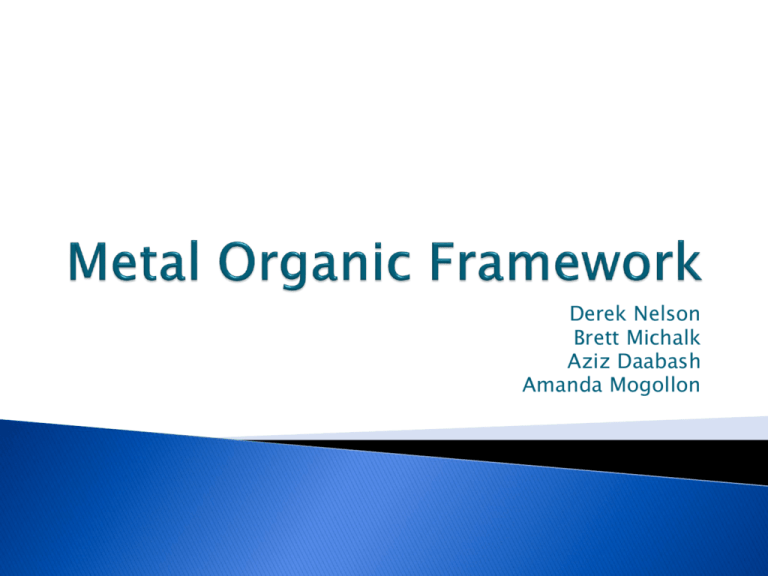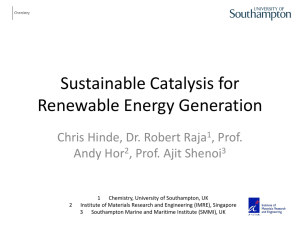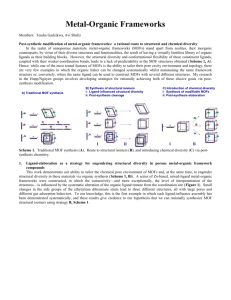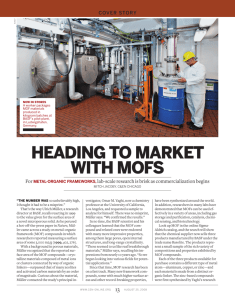Metal Organic Framework
advertisement

Derek Nelson
Brett Michalk
Aziz Daabash
Amanda Mogollon
Introduction
Molecular Rotors
Catalyst
Nanofibers
Drug carriers
Questions
atc.atccu.chula.ac.th/research_matsci.htm&usg=__
What is a MOF?
◦ Porous crystalline compounds forming 1,2 or 3
dimensional structures with the use of metal ions
◦ Consist of a metal ion and a
an organic molecule, often
called a ligand.
atc.atccu.chula.ac.th/research_matsci.htm&usg=__
x6BkSuEgRdYhQHOQJpVldt61WLQ=&h=488&w=512&sz=34&hl=en&start=3&um=1&itbs=1&tbnid=34sU9HfWWdTkfM:
&tbnh=125&tbnw=131&prev=/images%3Fq%3DMetal%2Borganic%2Bframework%26um%3D1%26hl%3Den%26sa%3DX%26tbs%3Disch:1
http://www.cup.unimuenchen.de/ac/klausmb/mitarbeit/muellerbuschbaum/bilder/mof-bild1.gif
MOF’s were born from zeolites,
porous crystalline structures
both found in nature and man
made
◦ Zeolites are made from
aluminosilicate materials
◦ Named from Greek when a Swedish
man observed water boiling out of
the rock
◦ Used in Chem-E industry as
catalyst and adsobant
www.lenntech.com/images/zeolite3.jpg
MOF’s are the next generation
◦ Sigma-Aldrich, with BASF, have
developed a MOF with the surface
area of a football field in 1 gram
mf.mpg.de
http://imghost.indiamart
.com/data/X/8/MY424310/mortar-andpestleporcelain_10732033_250
x250.jpg
http://images2.opticsplan
et.com/136180/opplanet-vwrdisposable-pellet-mixersand-cordless-motorv7338-901-0-5-mlpestle.gif
MOF’s have been
synthesized in 2 ways
◦ solvothermal techniques,
crystals are grown from a
hot solution of metal
precursor, such as a metal
nitrate solution
◦ mechanochemical
methods, grinding, to
produce, however these
are none porous
◦ mechanochemical
methods with the addition
of isonicotinate (ISA)
created porous 3D
crystals
http://www.cat-litter-critic.com/images/freshstep-cat-litter.jpg
MOF’s have limitless potential in many fields
◦ Porous
MOF’s large surface area to volume makes them
perfect to replace zeolites at every level when they are
available for mass production
◦ Solid
As solid structures produced by mechochemical
synthesis, MOF’s have very unique electrical properties
being explored
http://www.reflectscientific.com/im
ages/prod-graphitefabrication.jpg
Currently at the University of Colorado, Boulder
researchers are investigating the use of MOF’s to
replace liquid crystals for optoelectronic
applications
http://www.rsc.org/images/b808104b350-FOR-TRIDION_tcm18-128604.jpg
• Rotating or twisting
molecules under an electric
field is the principle behind
liquid crystals. MOF crystals
could lead to sturdier
materials to be used in the
data communications
industry
• Currently tested MOF’s do
not yet reach the barrier to
rotation to replace liquid
crystals
Structural and Catalytic Performance of a Polyoxometalate-Based MetalOrganic Framework Having a Lanthanide Nanocage as a Secondary Building Block
Dongbin Dang,†,‡ Yan Bai,‡ Cheng He,† Jian Wang,† Chunying Duan,*,† and Jingyang Niu‡
MOF’s have characteristics that lend
themselves to being excellent heterogeneous
catalysts
Zeolites are currently holding the market for
acidic catalysts
MOF’s require strong Lewis acid properties in
order to replace zeolites
for the cleaving of certain
compounds
http://www.chem.fsu.edu/~alabugin/Photos/dna_Cleavage_Cartoon.jpg
Strong Lewis acid
Polyoxometalates (POMs)
Heterogeneous Catalyst
◦ accepts a pair of electrons from another species
◦ Used in the nano cleavage of different
http://upload.wikimedia.org/wikipedia
molecules
/commons/6/6e/Dangclass8.png
◦ Inorganic oxo clusters that contain transition
metals
◦ Have many properties that can be used to
induce Lewis acid properties into MOFs
◦ For the purpose of this experiment hetero
catalyst has a higher conversion than homo
◦ Properties used to see if experiment was a
success
http://wwwback.jacobsuniversity.de/imperia/md/images/schools/
ses/facultypages/ukortz/image71_350x39
6.jpg
Compound {[Ho4(dpdo)8(H2O)16BW12O40] 3
2H2O}, compound 1, was thermally
crystallized from the solution
◦ HoCl3 36H2O, 4,40-bipyridine-N,N0-dioxide
hydrate (dpdo),HoH2BW12O403 nH2O, and
hexahydropyrazine (pz)
Compound 1 crystallizes as shown below
Dongbin Dang,†,‡ Yan Bai,‡ Cheng He
Synthesize a MOF with Lewis acid properties,
to create a very effective heterogeneous
catalyst.
Use the synthesized catalist to cleave a BNPP
molecule as shown
Use P NMR to monitor
the reaction kinetics
Dongbin Dang,†,‡ Yan Bai,‡ Cheng He
Dongbin Dang,†,‡ Yan Bai,‡ Cheng He
UV absorbance was used to determine if the
experiment was a success
The compound 1 MOF demonstrated
heterogeneous catalyst properties with a
high yield
Life cycle
◦ How long will the catalyst last
◦ Can it be regenerated?
Other MOF’s
◦ Can it be mechanochemically synthesized?
◦ Are there more efficient compounds?
Inhar Imaz, Marta Rubio-Martínez, Wojciech J.
Saletra, David B. Amabilino, and Daniel Maspoch
Creation of 1-dimensional infinite
coordination polymer particles (ICP’s) via
conventional coordination chemistry
ICP’s offer
◦ Promising functionalities
Magnetism
Porosity
Ion exchange
Optical properties
◦ Encapsulating matricies
http://www.rsc.org/ejga/CE/2006/b600447d-ga.gif
Martin et al. (2004)
Lin et al.
Oh et al.
You and Loh’s research groups
◦ First discrete metal-organic nanotubes by layer-by-layer growth.
◦ Created Gd(III) based nanorods used as contrast agents by waterin-oil microemulsion based technique
◦ Porous In(III) based hexagonal nanorods by hydrothermal
synthesis
◦ Creation of coordination polymer based gels and nanofibers.
Efficient in light harvesting due to 1-D structure.
http://www.aist.go.jp/aist_e/latest_research/2008/20081203_2/fig1.png
Purpose: Formation of long chiral coordination polymer
nanofibers
Conditions:
◦ Ambient conditions
◦ Use of aqueous/organic interfacial coordinative polymerization
Technique based on previous work involving Aspartic acid
reacted with transition metal ions to create biorelated
coordination polymers.
Amino Acid Based Metal-Organic Nanofibers Inhar Imaz,† Marta Rubio-Martínez
1) Aspartic acid and NaOH dissolved in EtOH/H2O
mixture (5:1)
2) Cu(NO3)2*6H2O dissolved in water.
3) Careful transference of both mixtures to a test tube.
4) After 3 days, fibers form at the interface of the
layers.
5) During the next 2 weeks, the ethanol layer diffuses
into the aqueous phase, and causes formation of the
fibers oriented along the direction of diffusion.
Amino Acid Based Metal-Organic Nanofibers Inhar Imaz,† Marta Rubio-Martínez
Photomicrograph image of
fiber bundles shows:
◦ Length
◦ High orientation
Transmission electron
microscopy (TEM) depicts
◦ Homogeneity of fibers
◦ Diameter
Field-emission scanning
electron microscopy (FESEM)
confirms the uniformity of the
sample as well as the narrow
diameter distribution.
Amino Acid Based Metal-Organic Nanofibers Inhar Imaz,† Marta Rubio-Martínez
Confirmation of 1-D structure
◦ Proposed formula [Cu(Asp)(H2O)x]n
◦ Energy dispersive x-ray confirmed
presence of copper, oxygen,
nitrogen, and carbon
◦ IR spectra showed bands at
wavelengths that suggest the
presence of carboxylate groups of
aspartic acid functional groups, and
they are coordinating to the Cu(II)
ions.
◦ Elemental analysis confirms 1:1 ratio
of Cu(II) ions and Aspartic acid
http://en.wikipedia.org/wiki/File:L-aspartic-acid-3D-balls.png
When the aqueous and organic layers are mixed
after addition to the test tube, an opaque blue
gel is created.
Upon further examination (FESEM) it is observed
that the gel is made up of homogeneous shortlength nanofibers.
This result indicates that the length of the
nanofibers is dependent on the method of
synthesis.
Amino Acid Based Metal-Organic Nanofibers Inhar Imaz,† Marta Rubio-Martínez
Long chiral nanofibers can be
grown using traditional
coordination chemistry and
biologically derived components by
utilizing diffusion controlled growth
procedures.
Simple changes in the experimental
procedure can have large effects on
the end product (nanofiber length
and orientation)
Highly flexible composition of
coordination polymers can have a
huge impact on future applications.
http://www.mpip-mainz.mpg.de/groups/landfester/projects/dc_sem_fig1
Rachel C Huxford, Joseph Della Rocca and
Wenbin Lin
Metal-organic frameworks
(MOFs) present a new way to
introduce drugs to the body.
Offer high drug loadings,
biodegradability, and
versatile functionality.
Reduction to nano-scale will
increase viability of MOFs to
act as drug delivery vehicles.
http://www.dcfe.unimi.it/sezion3.jpg
Lots of progress in the
understanding of diseases, but
not nearly as much progress in
the treatment of those
diseases.
MOFs can help to target
specific distribution areas
(tumors for example) and will:
◦ Lower the required doses
◦ Extend the time the medication is
in the body
◦ Optimize pharmacokinetics
◦ Reduce side-effects
http://img.thebody.com/legacyAssets/08/76/cover.jpg
Important properties for MOFs used as drug
transporters:
◦
◦
◦
◦
◦
◦
◦
◦
Size
Drug loading
Surface properties
Drug release kinetics
Improved pharmacokinetics
Biocompatibility
Tissue specificity
Multiple agent engineering
http://2.bp.blogspot.com/_lfgsdvQ8GyY/SlOavkX6KUI/AAAAAAAAKUc/sx4FZPfhmg/s1600-h/metal-organic-carbon-capture_1.jpg
Major goal is to design a
carrier that both the ligand
and transition metal used
exhibit little toxicity to the
human body.
Iron, copper, manganese,
nickel, and zinc are all found
in the human body, however
little is known about possible
biological downfalls to each
of these metals.
http://houseofhackers.ning.com/photo/toxic-1
Materials of Institut Lavoisier (MIL)
Trivalent metal centers with carboxylic
bridging ligands
Large pores (25-34 Å)
Large surface area (3100-5900 m2/g)
Functional group incorporation
Two MOFs studied, MIL-100 and MIL101
Metal–organic frameworks as potential drug carriers
Rachel C Huxford, Joseph Della Rocca and Wenbin Lin
Both MIL-100 and MIL-101 are chromium based and are
tested with the storage and release of ibuprofen.
Drug loading
Drug release
◦ MIL-100 0.347g ibuprofen/g MOF
◦ MIL-101 1.376g ibuprofen/g MOF
◦ Difference attributed to pore size of MIL-101 at 12700 and 20600
Å (8200 and 12700 Å for MIL-100)
◦ Tested using simulated body fluid at 37 °C
◦ MIL-100 Initial release within two hours with full release after
three days
◦ MIL-101 Steady release for eight hours with full release after
six days
http://www.itg.uiuc.edu/technology/reconstruction/scaffold-cells.jpg
The chromium used is highly
toxic in the human body, so an
iron analog, MIL-101(Fe) should
be used as a more suitable drug
carrier.
MIL-53 is another MOF in the
MIL family that has properties
that make it desirable for long
release (3 weeks) medications.
MIL family has the highest drug
loading capabilities of any
material previously studied.
http://struktur.kemi.dtu.dk/kenny/MIL_53_b.JPG
MIL family have hydrophobic pores, but what
about MOFs that use hydrophilic pores?
The hydrophilic pores will hold a positive or
negative charge, and the drug used will
contain opposite charges to the MOFs.
The Rosi group created a MOF consisting of
zinc(II) ions, adenine, and para-biphenyldicarboxylic acid.
This MOF can be cationically triggered to
release the drug contained inside.
Storage
◦ 0.22 g drug/g MOF
◦ Loaded with a hydrochloride salt of procainamide
Release
◦ Previously this drug is generally limited by its rapid
exit from the body, and requires re-dosing every
three to four hours
◦ Use of MOF extended release time to 72 hours.
Metal–organic frameworks as potential drug carriers
Rachel C Huxford, Joseph Della Rocca and Wenbin Lin
Gaseous therapeutic
carriers – Nitric Oxide
◦ Antibacterial
◦ Antithrombotic
◦ Wound healing applications
MOF made from cobalt or
nickel and 2,5dihydroxyterephthalic acid.
◦ Can absorb seven times
amount of NO as any other
MOF
◦ Has little background release
Metal–organic frameworks as potential drug carriers
Rachel C Huxford, Joseph Della Rocca and Wenbin Lin
NO loaded MOF tested on pig coronary
arteries induced vessel relaxation
Nickel and Cobalt are too toxic for biological
applications, but this work shows the ability
of MOFs to carry and release gaseous cargo.
http://pubs.acs.org/cen/img/83/i34/8334cov1aopening.gif
Previously discussed MOFs
cannot work because of
large size.
A reduction to the nano
scale (nMOFs) will allow
systemic circulation
through the body while
retaining the properties of
bulk MOFs
Big Picture:
Pharmacokinetic
improvements!
http://www.sciencedaily.com/images/2007/06/070627084654-large.jpg
Lin group fabricated nMOF designated NCP-1
Once the MOF reaches the cancer cell, the drug is
reduced to a more toxic form to kill the cancer cell.
◦
◦
◦
◦
Tb3+ ions and disuccinatocisplatin (DSCP)
~58.3 nm in diameter
Encapsulated in silica to enhance stability
Functionalized with c(RGDfk) to target an integrin over
expressed in many cancers
Metal–organic frameworks as potential drug carriers
Rachel C Huxford, Joseph Della Rocca and Wenbin Lin
Lin group also loaded a nano form of
MIL-101 with a cancer prodrug and
imaging agent.
Addition of imaging agent suggests
possible future of real time monitoring of
the therapeutic response to the drug.
http://healthinfoispower.files.wordpress.com/2009/10/ec20rev.jpg
Drug carriers can be formed from a vast amount of
metal centers and connecting ligands to find desirable
characteristics for the specific application.
Many different drugs can be incorporated into the MOF.
Therapeutic drugs in conjunction with imaging agents
offer new ways to study the real time effects of
medications.
Metal–organic frameworks as potential drug carriers
Rachel C Huxford, Joseph Della Rocca and Wenbin Lin
Investigate the toxic effects of metals already
found in the body for use in nMOFs
Explore additional slow release mechanisms
for prolonged exposure to the drug.
Design nMOFs for large surface area/volume
ratio to maximize drug loading capabilities.
Research coatings that will increase the
stability of the nMOFs and possibly help
contain the drug inside until the desired
location is reached.
http://www.granitegrok.com/pix/question%20mark.jpg
Rebuttal Group from U4
Oral Presentation and Slides
• We agree that their should have been an introduction slide, instead
of just assuming the audience realized the entire front matter
before the three papers were the introduction.
• We agree that the Catalyst Paper slide title was inappropriate and
should have matched the other two papers by using the title of the
paper for the title of the slided.
• We agree that we should have stuck on one naming convention for
metal organic frameworks, either saying its full description the
whole time, or by condensing it to MOF every time after defining it
in the introduction. We apologize for any distraction that this may
have caused.
• We agree that some slides should have contained larger pictures,
but for the most part we think that we filled the slides in nicely with
ample text/figures.
Technical
• We agree that our introduction was lacking in technical
information to provide the audience with a complete
background for the papers.
• We also agree that in the first paper the
heterogeneous/homogeneous catalyst properties should have
been better explained.
• We agree the second paper was very well structured and
presented, however we also agree that we should have done
more to explain how this research will further research in the
field.
• The third paper was not very descriptive on how the drugs
target certain areas of the body. We should have done more in
depth research to inform the audience that the ligand can be an
amino acid that helps the MOF move to a targeted area.
• Overall we agree that we should have had a technical summary
and additional research and benefits of our presentation
U1 review of U4
Metal Organic Framework
Definition;
◦ consisting of metal ions or
clusters coordinated to often
rigid organic molecules to form
one-, two-, or three-dimensional
structures that can be porous
Importance;
◦ Have potential to replace zeolite
◦ Have unique electrical properties
that will be very useful in future
electronics and computing
http://medgadget.com/archives/2008/02/organic_metal_h
ybrids_promise_materials_of_the_future.html
About the presentation
Overall presentation
◦ Well presented, well organized, clear slides and great
research work. Thank you for the superb
presentation.
Time length
◦ It was little off the time limit of 30 minutes but it
wasn’t a boring presentation.They did well to engage
the audiences and it was a very good stuff to learn
Food
◦ Provided (thank you)
Impact
◦ We have an opportunity about the MOF and about
the research going on this topic
◦ It is very helpful for some of us who is considering
nano-research as their career
Final thoughts
◦ Such presentation will help in developing the
research and presentation skills for undergraduate
students like us.
http://www.aps.anl.gov/Science/Highlights/Imag
es/APS_SCIENCE_20080729-1.jpg
Review of Group U4’s Presentation-
By Group U2:
-Kyle Demel
-Keaton Hamm
-Bryan Holekamp
-Rachael Houk
http://www.rsc.org/images/MOF%20image_tcm18-150592.jpg
The presenters did really well at:
Food – This group by far brought the best food to class. Ice cream sandwiches,
cookies, cupcakes… how could we not give you an ‘A’ just for that?
Figures – The graphics used throughout the presentation were pertinent to the
topics being presented. The use of graphics was very important to help
demonstrate the material being discussed. The group did a good job of
incorporating graphics onto every slide.
Structure – The group followed a clear presentation and structure order. They
provided an outline and stuck with it. The outline could have been done better.
The topics in the outline were vague and did not properly summarize each section.
Articles – The presenters chose appropriate articles for this presentation. A total
of three articles were used. This is very impressive considering that most groups
chose to only report on one pertinent article during their presentation. The
speakers discussed metal organic frameworks with respect to
catalysts (very important considering the reaction engineering
that many students have learned), amino acid nanofibers
(incorporating biology with our nanotechnology discussion),
and potential drug carriers (which builds off of previous
groups’ presentations.
http://pubs.acs.org/cen/images/8003/8003notw1sphere.gif
The group could improve at:
Timing – The group needs to do a better job coordinating the speaking parts and
for how long each group member will talk. Only two of the group members
presented, which is fine, but of these two members, one spoke for five minutes,
and the other spoke for twenty-five minutes. That is clearly malproportioned.
The speakers should practice together ahead of time to smooth out transitions and
even out the amount of speaking parts.
Background – The background was very brief, and predictably, not very
informative. The speakers rushed through the introduction in about two or three
minutes. More time should be committed to communicating the basic material.
Slide Format – The group clearly went with a template formatting and meshed all
the sections together. This led to striking inconsistencies in formatting. The text
and heading size varied between the slides. Most slides also had too many words
on them. These should be short bullet points, not paragraphs! The figures also
need to be bigger. There is too much blank space on the slides. Space the text out
more if you have to, but do not leave half a slide blank without reason.
Stronger Beginning & End – The opening was kind of weak; the
intro slide was bland and the outline was not very well done. Also,
the conclusion was sort of abrupt. You need to summarize what
was discussed during the presentation.
http://www.matternews.com/Images/metal-organic-frameworks.jpg
Undergrad 2nd Review for Group U4
Metal Organic Frameworks
Krista Melish
Phillip Keller
Group U3:
James Kancewick
Mike Jones
Presentation Review: Ugrad #4
Presentation Review
Introduction
The papers covered after the introduction should
have been mentioned even if each paper has its
own intro slides. This would help the audience to
see where the presentation is going.
Intro slide communicated all necessary
information to understand the problem and
experiemnt.
The theory slide could have been more effective.
The last bullet about heterogenous catalystdoesn’t
seem to be correctly integrated. Heterogenous
catalysts simply are ones that have reaction sites
within them. Zeolites and MOF’s are both
heterogenous catalyst types.
Explanation of the mechanism of using
polyoxometalates to obtain the desired behavior in
the MOF could have been done better.
Paper 2: Amino acid based metal organic nanofibers
The introduction contained good information to
describe what MOF’s are, but we would have liked
to see more information on their history.
Paper 1: Catalyst
Paper 3: MOF’s as potential drug carriers
.
Effective introduction to the topic, and especially liked
the history which put it in perspective.
The experiemnt and results where both explained well,
and in a way that was easy to understand.
The only thing that should have been better clarified are
the specific positive properties this ICP yielded. The
intro mentioned some areas where the might ne useful,
but there wasn’t much on how this experiment might
affect future things. It seemed like it didn’t have an end
goal in mind in advancing the field.
It is not apparent how MOF’s can help target specific
distribution areas in the body as mentioned in the intro.
The rest of the information is correct, but MOFs can’t
distinguish between different areas of the body.
Good job explaining how high surface area of MOF can
lend istelf to storage and release of medications, as well
as why this fact is important.
Experimental results were presented in an easy to
understand way. The point was clear, and the limtations
of the mofs due to their toxicity was also clearly
presented. Would have liked a slide on the specific
methods used to create the MOFs.
Review Of Group U4 by
Group U5
Oral skills and preparation very
good.
First speakers seemed to have
practiced and knew their
information but later speakers
needed more work.
Great slide quality and
sequence. A lot of pictures,
figures, and graphics that were
helpful for understanding
http://www.rsc.org/images/b808104b-350FOR-TRIDION_tcm18-128604.jpg
Very good introduction.
Liked how they described
what MOFs were, but
would have liked to learn
more about their history
and past work more.
Choice of papers were
relevant and interesting
Did not like how they
nicknamed the first paper
“Catalyst Paper.” Would
have preferred for them to
use the actual title of the
paper
Dongbin Dang,†,‡ Yan Bai,‡ Cheng He
Dongbin Dang,†,‡ Yan Bai,‡ Cheng He
Jaynesh Shah
Greg Pudewell
Edwin L. Youmsi Pete
John Pack
http://www.sciencedaily.com/images/2007/06/070627084654large.jpg
Both speakers were loud,
clear, audible and
maintained eye-contact
They were confident and
sounded knowledgeable on
the subject
The slides were visually
appealing and consistent
All the graphics in the
slides were appropriately
cited and were relevant to
the topic
http://news.softpedia.com/images/news2/HowDangerous-Are-Nanoparticles-2.jpg
Speakers made good use
of technical jargon
The papers discussed
were relevant and
interesting
Could and should have
discussed further
research a little bit more
http://www.rsc.org/images/b808104b-350FOR-TRIDION_tcm18-128604.jpg
Metal Organic Framework
Presented by: Group U4
Critiqued by: Group U6
PavitraTimbalia + Michael Trevathan
http://www.scientificamerican.com/media/inline/metal-organic-carbon-capture_1.jpg
Critique: Oral Presentation & Slides
http://www.how-tostudy.com/images/otherhelpful-articles/making-an-
oral-presentationspeaking.gif
Slide Background made the font easy to read and the pictures easy to see
The “Overview” slide did a good job summarizing the topics ahead
Should have had a slide which said “Introduction”
Instead of saying “Catalyst Paper” could have just placed paper title
The group did a good job in having graphics on each of the slides –
however, one or two slides did not have any graphics
All of the graphics were referenced – good job
We did not like the way the slides end – maybe need an overall
conclusion slide to tie things together
The group presented well – the other two members presented for this
presentation
Both presenters kept good eye contact with the
audience and good posture (Both were also dressed in business clothes)
The first speaker spoke too fast – more practice could have helped him
pace his talk better instead of making the presentation look rushed
The second speaker was very thorough in his analysis of the two papers
and did a good job in explaining the research
http://www.beatsworking.tv/greatrex/eyecontact.jpg
Critique – Technical Content
Introduction was a bit rushed because of pace of speaker
It was, however, concise and gave a good overview of metal organic frameworks
Choice of research papers seemed relevant to topic discussed
Three papers discussed which gave a good range of information on current research
The second and third papers were more in-depth with the analysis
The paper on drug carriers was the most interesting since to us – the research could
assist advanced in the medical field
Each of the papers covered recent research in the field
http://www.medgadget.com/archives
/img/54747por.jpg
The motivation for each paper given at the beginning - something we really
liked
Further research was incorporated at the end of the slides for each paper –
would have liked to see the impact of this research in the future
Like we said before, the presentation ended abruptly – would have liked to see
a conclusions/summary slide or an overall further research slide
We feel that there should have been a “Works Cited” slide to let the audience
know which references were used – they were not all cited well in the
presentation
http://www.bioinfo.mpg.de/euclis/General/images/clockReferences.jpg
Review for U4
Jung Hwan Woo
• Overall, the presentation and the slides were
great.
• The presentation contained several different
applications. It was a good approach as it
could introduce more applications of MOF’s to
the audience. However, this approach resulted
in the lack of depth in some of the research
topics introduced.
• Some of the slides were a bit crowded with
text but it was ok.
• I liked the “option 1, option 2, etc.” approach.






